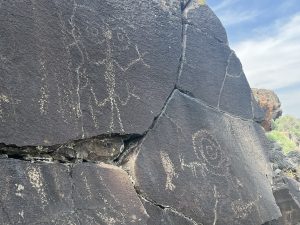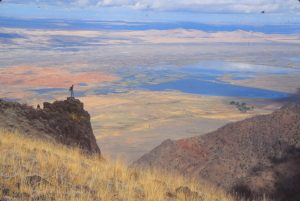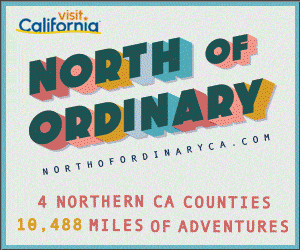Bighorn sheep, a soothing hot spring, ancient petroglyphs, wide open vistas and, just as its name implies, pronghorn antelope. Southern Oregon’s Hart Mountain National Antelope Refuge has a lot to offer, a verdict confirmed by the late U.S. Supreme Court Justice William A. Douglas.
“This is a land to possess and embrace,” Douglas wrote in his book, My Wilderness: The Pacific West. “It is a land to command as far as the eye can see.”
There’s much to see at Hart Mountain, a 278,000-acre wonderland that’s best explored on foot, mountain bike, or horse. I’ve been visiting Hart Mountain for 30 years, and it remains a thrill. The roads are unpaved and many can only be traveled by high clearance vehicles. Actually, the refuge has few “trails.” Most are routes, some as steep as elevator shafts that descend or ascend canyons carved on Hart’s western slopes, while others require cross-country treks across vast expanses of sagebrush and junipers. With friends, family, and park staff, I’ve scrambled up and down Hart and DeGarmo canyons, ridden horseback along Poker Jim Ridge, and woven through aspen-lined thickets.
The one place most people visit is the enclosed hot springs near the Hot Springs Campground. A rock wall shields a 10×15-foot pool where the bubbling water generally ranges from about 100 to 105 degrees.
From the campground, a rumpy, rocky road that’s easier hiked than driven provides access to some of the refuge’s rugged High Desert terrain. It’s slightly more than two miles to the Barnhardi Cabin, a falling-apart plank shack that recalls times when sheep and cattle grazed the refuge’s vast expanses. From there it’s possible to forge on to Warner Peak. At 8,017 feet, it’s the highest point in the refuge, with westward views of neighboring Warner Valley more than 4,000 feet below. As Douglas wrote, Hart Mountain “rises like a gargantuan loaf from dry prairies of Southeastern Oregon.”
Hiking along the ridgeback, I’ve come face-to-face with curious buck antelope. While heading into Hart, Potter and DeGarmo canyons I’ve been nearly trampled by suddenly flushed mule deer and, one memorable time, startled bighorn sheep. Fittingly, the refuge, which spans more than 422 square miles, was created in 1936 by President Franklin D. Roosevelt to serve “as a range and breeding ground for the antelope (pronghorn) and other species of wildlife.”
That’s appropriate because wildlife and birds are among Hart Mountain’s attractions. With its diverse terrain the refuge is home to more than 300 species of wildlife. Along with pronghorn—and it’s almost impossible to not see several in even a quick pass-through visit—the refuge provides habitat for more than 40 species of mammals, such as California bighorn sheep, coyotes, deer, and rabbits, along with about 240 bird species, including sage grouse, best seen in the spring mating season.
One night, while soaking in the hot spring, I listened to yipping coyotes and, as the wind whistled past, sat back as clouds raced across the sky. Another night, while walking back to camp, a noiseless owl swooped just above my border collie. Then, just as quietly and quickly, it swooped back into the trees, waiting for smaller pickings.
Several times I’ve driven to a signed roadside parking area and walked 1.6-miles to Petroglyph Lake. The name comes from petroglyphs, symbols and images painted on cliff faces by prehistoric Indians. The images, located on cliffs above the lake’s western shore, are varied and indistinct, and what they represent is subject to speculation. That’s part of the intrigue. Some are geometric patterns while others are zoomorphic or in the forms of animal-like images. One appears to be a giant bug, while another is distinctly horse-shaped. Some are human images, including one body with a weird bug-like head. But, please—look but don’t touch!
It’s believed the petroglyphs (petro meaning stone or rock and glyph meaning to carve) were created more than 10,000 years ago. The genesis of petroglyphs evokes speculation. As one “expert” wrote, “Because modern Oregon tribes have no similar painting traditions or legends, the petroglyphs may well be the work of a different people—a mysterious, earlier culture that hoped to communicate with the spirit world through symbolic messages at sacred sites.”
One late afternoon, friends and I sat tucked under the petroglyphs, while on the opposite side of the lake, pronghorn rams took turns guiding groups of about 20 ewes and lambs to water at the lake. They stood guard then escorted their charges back upslope as another ram led another group to water. Then, as the setting sun cast a crimson glow, the rocks above rattled and clattered, like the sound of a fleet of pickup trucks. Minutes later the first of several bighorn rams gingerly followed a rocky path from the rocks behind us to the lake, where he slurped a long drink before retracing his steps. Over the next half-hour, a series of wary rams repeated the cycle, one at a time.
I’ve hiked along canyons and ridgetops in search of bighorn. One evening, after spying more than 20 bighorns from the road that connects the refuge with the nearby village of Plush, I parked my car, snuck up a side canyon and climbed to the top of the rocks. I never saw a single sheep. Disappointed, I hiked back to my car to find it surrounded by curious bighorns.
Many times I’ve marveled at a coloring-box array of flowers—paintbrush, corn lilies, arrowleaf balsamroot, woolly groundsel, showy penstemon, waterleaf, longleaf phlox, lovage, western blue flax, elk thistle, larkspur, wild buckwheat, false hellebore and many, many more. Common, too, are a variety of shrubs—wax currant, antelope bitterbrush, mountain snowberry, rabbitbrush, little-leaf horsebrush, and sprawling fields of big sagebrush, along with occasional stands of mountain mahogany, western juniper, and, along areas of Rock Creek, proliferations of water-loving quaking aspens.
Spending time at Hart Mountain proves that Justice Douglas handed down a correct verdict. It truly is land to possess and embrace.
When You Go
The Hart Mountain National Antelope Refuge is 65 miles east of Lakeview, the nearest major town. Take Highway 395 north for about five miles, then go right (east) on Highway 140, left at a well-marked intersection 19 miles from the intersection and another 19 miles to Plush, the last community with gasoline and basic groceries. Several miles after Plush—follow the signs—the paved road gives way to an improved gravel road the final 36 miles uphill to the refuge headquarters. Along the drive, stop at a well-marked pullout with a short trail to the dramatic Warner Valley Overlook.
Camping is available at Camp Hart Mountain, a former Civilian Conservation Camp at the base of the mountain. It’s recommended for people towing trailers or with large RVs. Five miles from refuge headquarters is the popular Hot Springs Campground. Camping is also available at Post Meadows, which has corrals for horses, six RV/campsites and an open area for tent camping.
For information call the Sheldon-Hart National Wildlife Refuge headquarters at 541-947-3315 or visit the refuge website at www.fws.gov/refuge/sheldon. The Friends of Hart Mountain, a non-profit volunteer managed group that supports the refuge, sells T-shirts, hats, coffee mugs to help sponsor programs. To learn more, visit
www.friendsofhartmountain.org. Before hiking, check with refuge staff on possible closures.

















